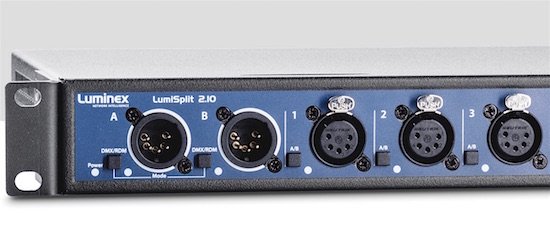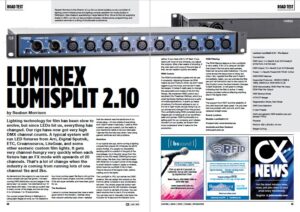News
22 Jul 2019
Luminex Lumisplit 2.10

Subscribe to CX E-News
ROAD TEST
Luminex Lumisplit 2.10
by Reuben Morrison.
Reuben Morrison is the Director of Lux De Lux (www.luxdelux.co.nz), a provider of lighting control infrastructure and lighting console operation for movie studios in Wellington, New Zealand, specialising in large feature films. Since its first job supplying Avatar in 2007, Lux De Lux has provided consoles, infrastructure, programming, and operation services to a string of blockbuster productions.
As demand and the urgency to use more and more complex set-ups has grown, I’ve been running DMX distribution around stages in the same way I run power. I’ve matched all our 10 amp feeds with data. I now set-up a patch bay in every corner of the stage, and we can plug in to Universes 1 to 16 everywhere.
Our current project filming in Wellington is using eight stages at once, so I’ve needed to buy more Luminex gear!
We like to roll-out the same rig for every project, and the LumiSplit 2.10s are super versatile, and have been good for us.
The Backbone
I came to Luminex because they have a really good name in the industry. I started using their network switches back when I realised that the network was the backbone of my whole setup – it’s the middle of everything and I hadn’t taken it seriously.
I used to think a switch was just a switch, but the reality is your backbone needs to be your best gear. I learned this the hard way when I was using generic switches and had problems.
Workflow
In our typical set-ups, we’re running a lighting console that outputs 32 Universes via sACN and/or ArtNet. It’s usually my GrandMA2 sending sACN to a switch in the grid of the soundstage. Up in the grid, we go from the switch to two NZ-made, DMXKing four-port DMX nodes. We then drop Cat6 terminated with EtherCon in to each corner of the stage, to small network nodes in cases on wheels, which have the LumiSplit 2.10s in them.
They’re the end of the signal chain, before cabling out to the lights.
 The LumiSpilt is 1RU, but carries two DMX streams. We can assign the outputs on the front for either Universe in any combination we want. You simply press the button next to the output and its LED indicator changes colour; A port is red light, B is blue. You can teach anyone how to use it, it’s so simple.
The LumiSpilt is 1RU, but carries two DMX streams. We can assign the outputs on the front for either Universe in any combination we want. You simply press the button next to the output and its LED indicator changes colour; A port is red light, B is blue. You can teach anyone how to use it, it’s so simple.
You can also lock it manually; hold down the A button for 8 secs and its indicator turns yellow. If you mess with it, it’ll flash. If you need a bit more of one Universe, you adjust the outputs. After a few weeks of shooting, if the crew want a bit more of this and less of that, we can repatch quickly and easily.
RDM Control
The RDM functionality is great and we use it constantly. Adjusting fixtures via RDM means we don’t have to climb, we don’t need riggers to go into truss, and we don’t need harnesses. It makes it really easy to change the personality and modes of the Arri Sky Panels.
We implement RMD control via a handheld City Theatrical DMXcat, which is a small hardware interface device and a suite of mobile applications. It opens up heaps of options; if a fixture’s address is out, or it’s not in right mode, we just bring it up on our phones and change if from the ground.
The LumiSplits being RDM compliant are an integral part of making all of our workflows safer and quicker. RDM functionality is a selling point for our company, and I always include it on our quotes, as those in-the- know understand what it means for the production.
RDM Filtering
The RDM filtering feature on the LumiSplits is very useful. If an LD is using an old light that doesn’t like the extra data packets, there can be some weird behaviour. I’ve only come across the issue once or twice, but when I did, I applied the filter and it fixed it immediately.
Again, you can activate the filter per port via the button next to the output; hit the A button once, the blue indicator changes to light blue/cyan, or red goes to orange, indicating that the filter is active. It neatly solves a problem without affecting anything else in the signal chain.
Support
The support from PAVT and the reliability of the units have both been great. I’ve only ever had one problem with one unit, and it was replaced straight away.
Brand: Luminex
Models: LumiSplit 2.10
Product Info: www.luminex.be
Australia and New Zealand: www.pavt.com.au
Luminex LumiSpilt 2.10 – The Specs
Connectivity
DMX Input: 4 x Neutrik 5 pin XLR (male) (2 at the front, 2 at the rear)
DMX Output: 10 x Neutrik 5 pin XLR (female)
Power: 1 x Neutrik PowerCON TRUE1 In/Out
DMX/RDM Features
Supported Protocols – DMX512 (1986 & 1990), DMX512-A, RDM ANSI E1.20
RDM Discoverable, RDM Filter Per Input, RDM Filter Per Output
DMX Backup Mode
HTP/LTP Merger
Regeneration Mode, Dark Mode
DMX Zone Selection
2 User Presets Optic and galvanic DMX isolation per port (except THRU)
Physical
WxDxH: 482 x 204.85 x 44 mm
Weight 2.54 kg
CX Magazine – July 2019 Entertainment technology news and issues for Australia and New Zealand – in print and free online www.cxnetwork.com.au
© CX Media
Subscribe
Published monthly since 1991, our famous AV industry magazine is free for download or pay for print. Subscribers also receive CX News, our free weekly email with the latest industry news and jobs.









